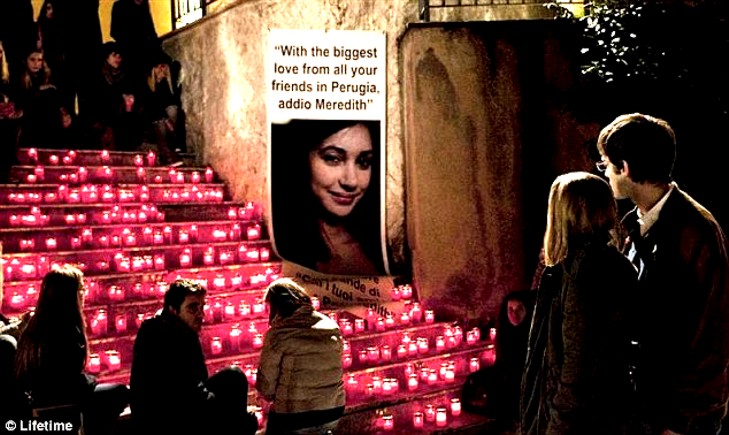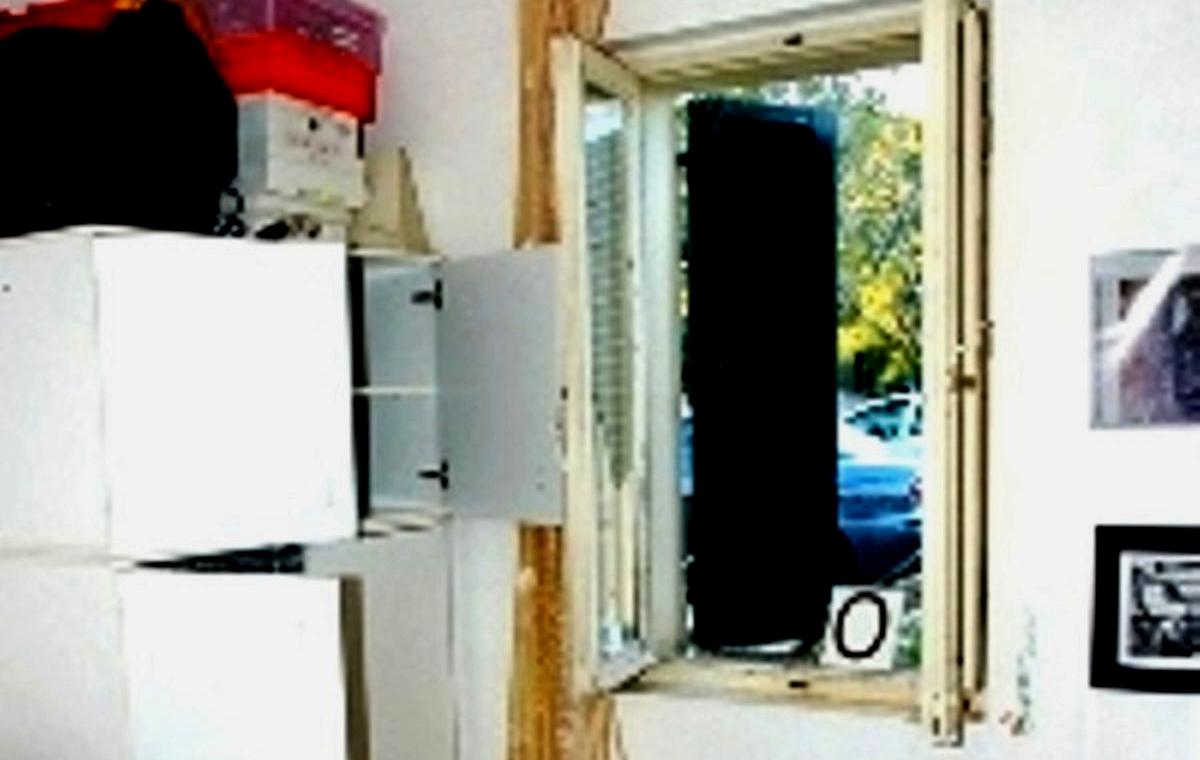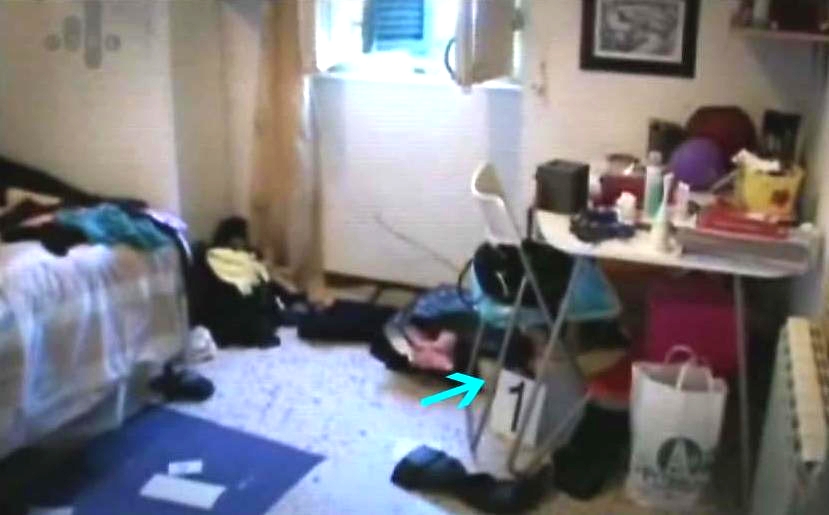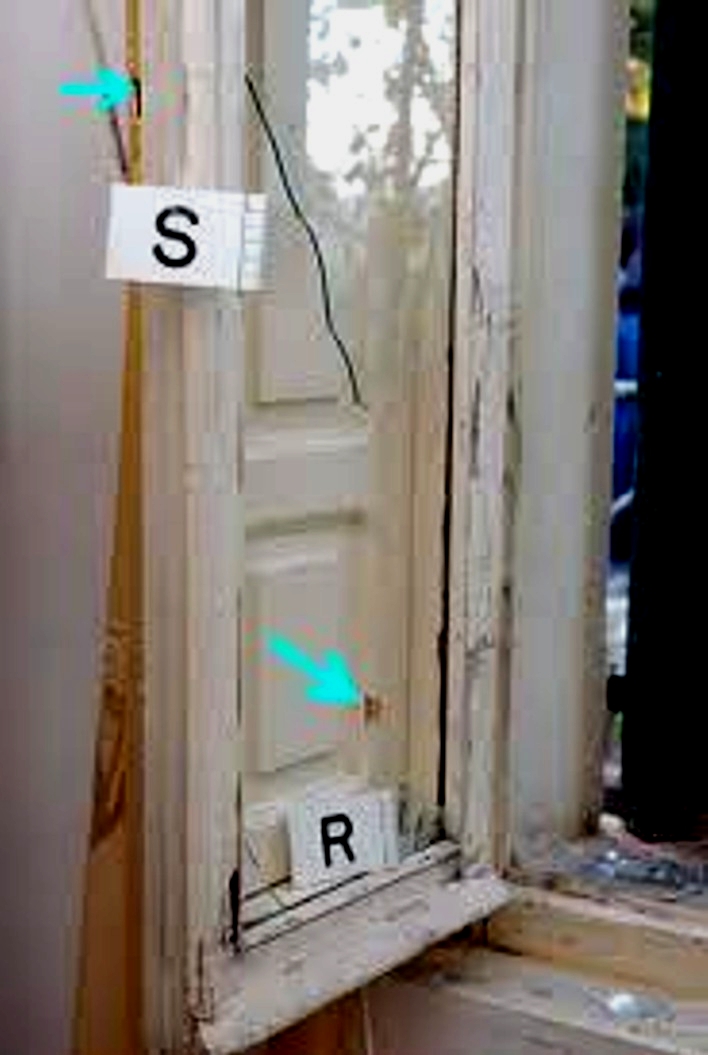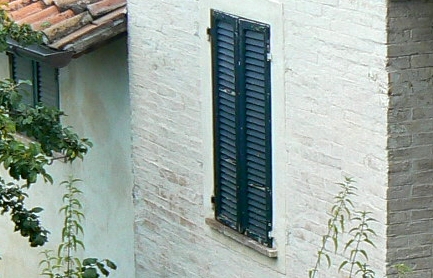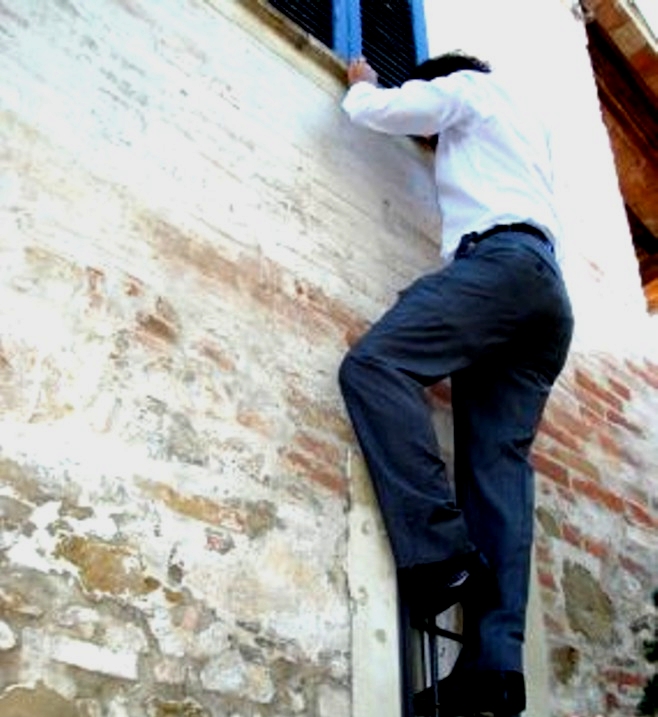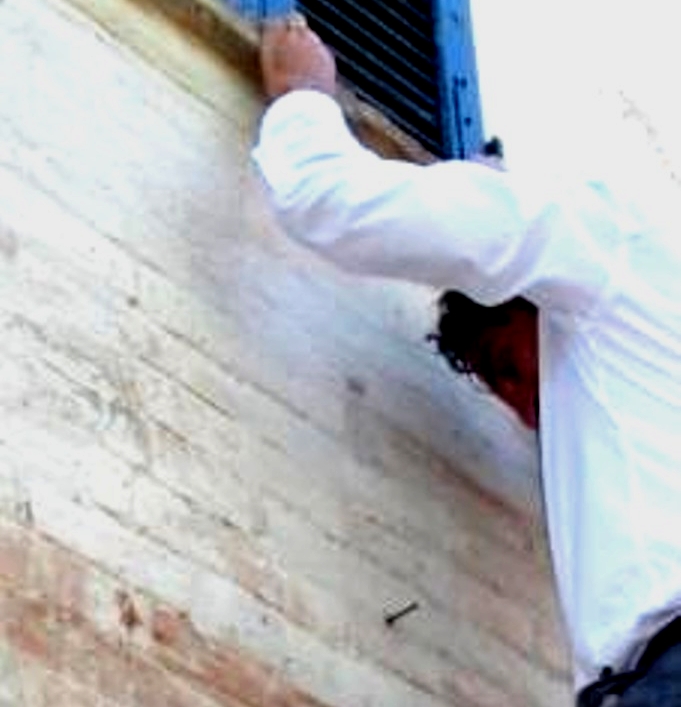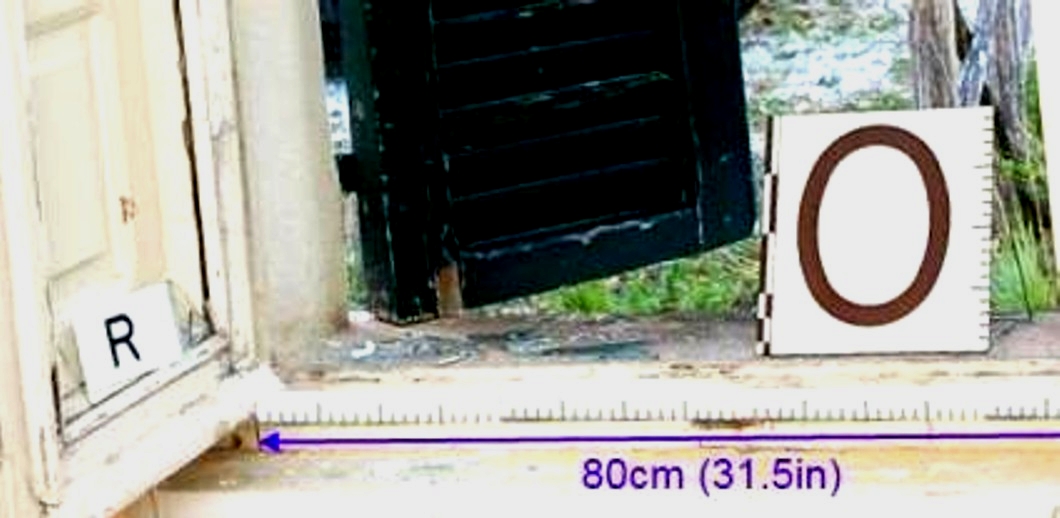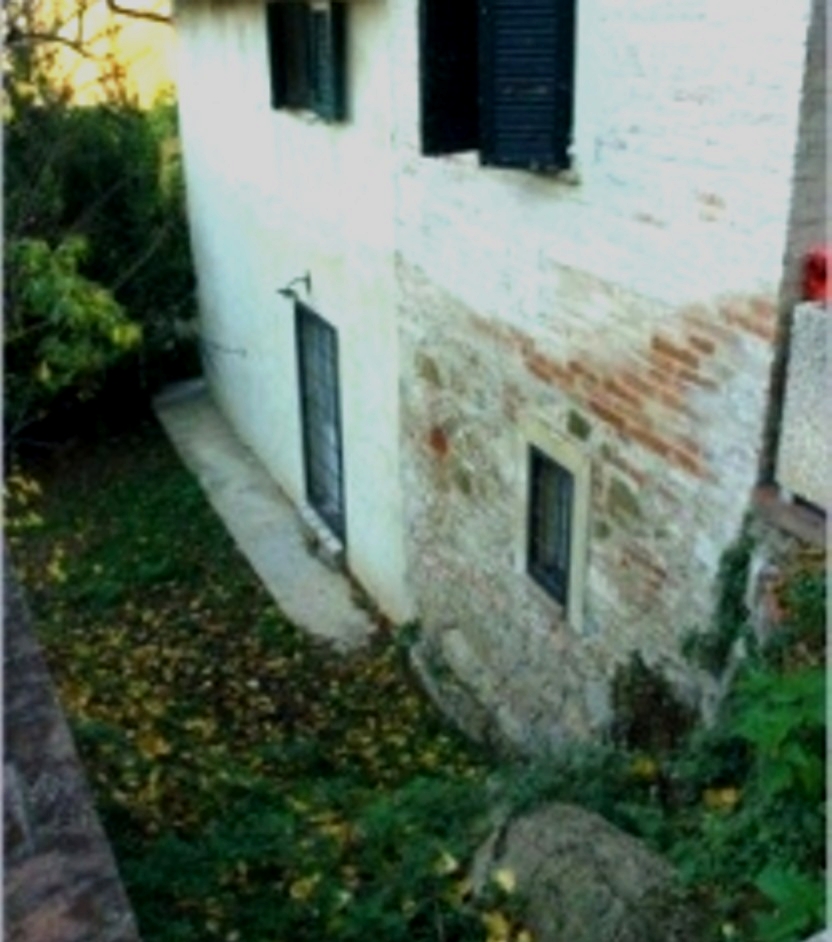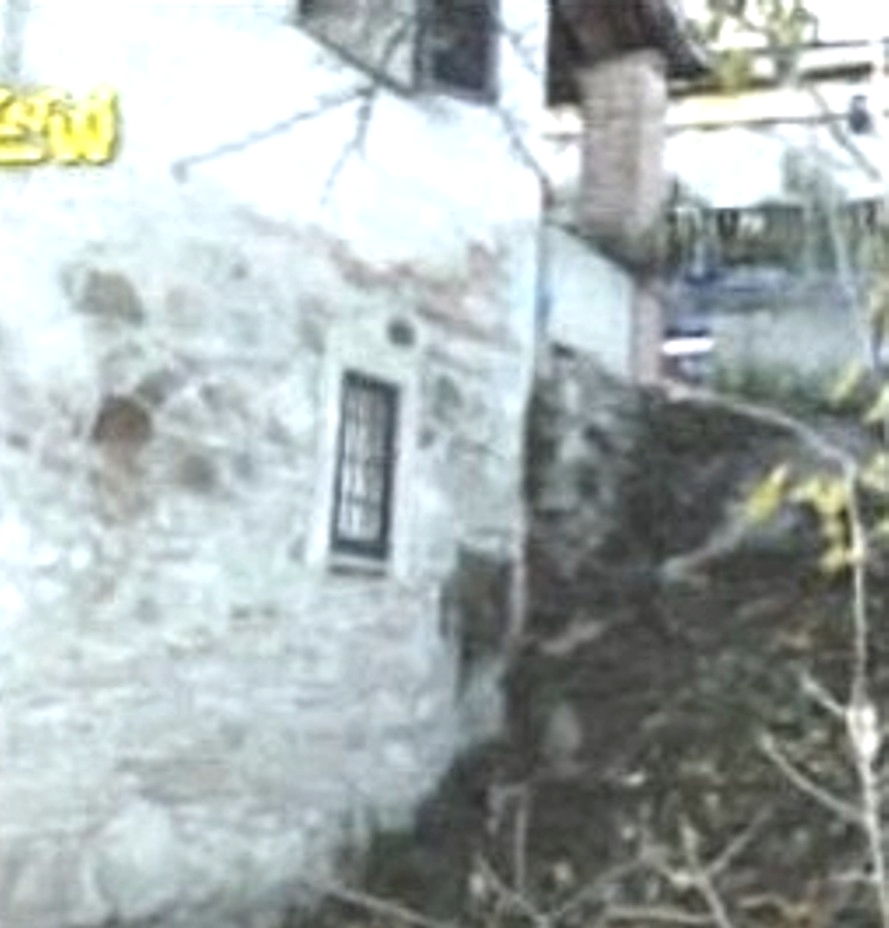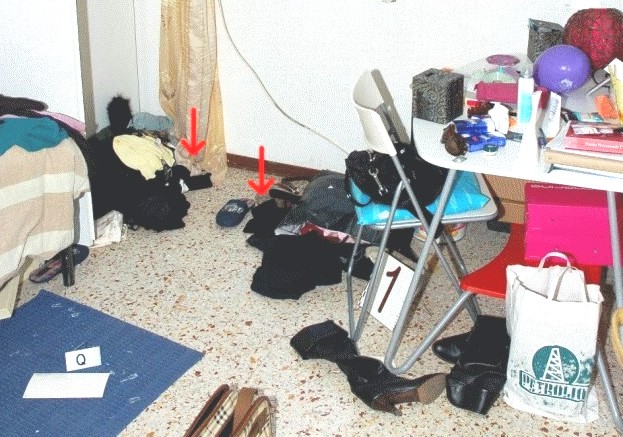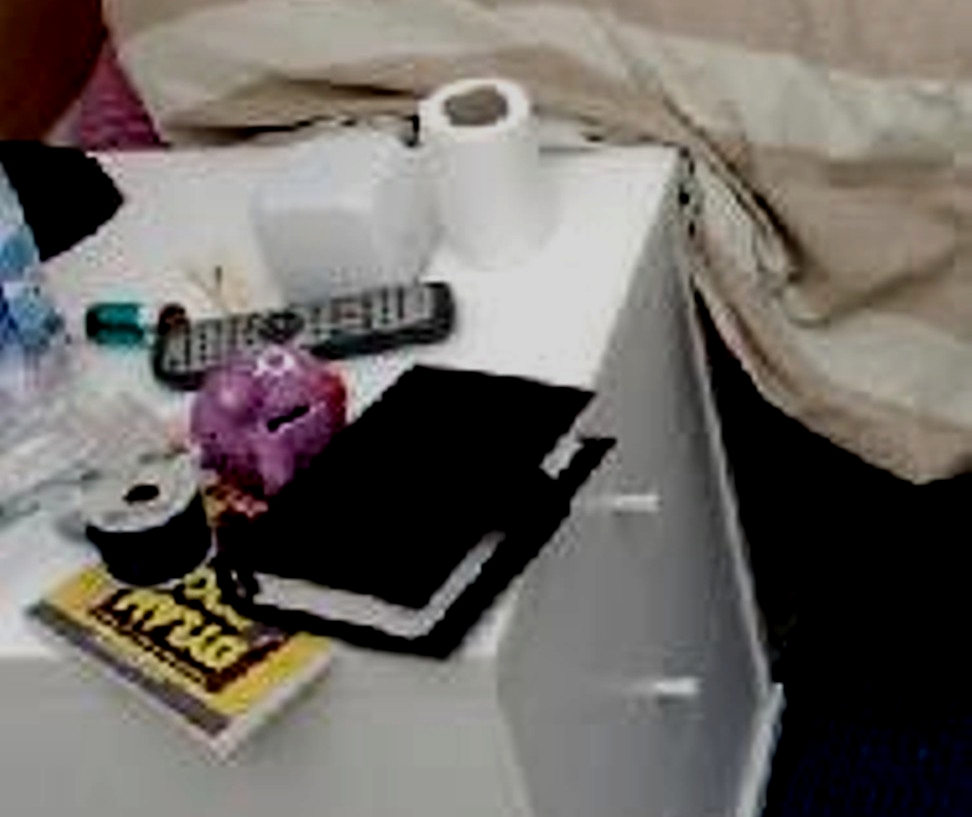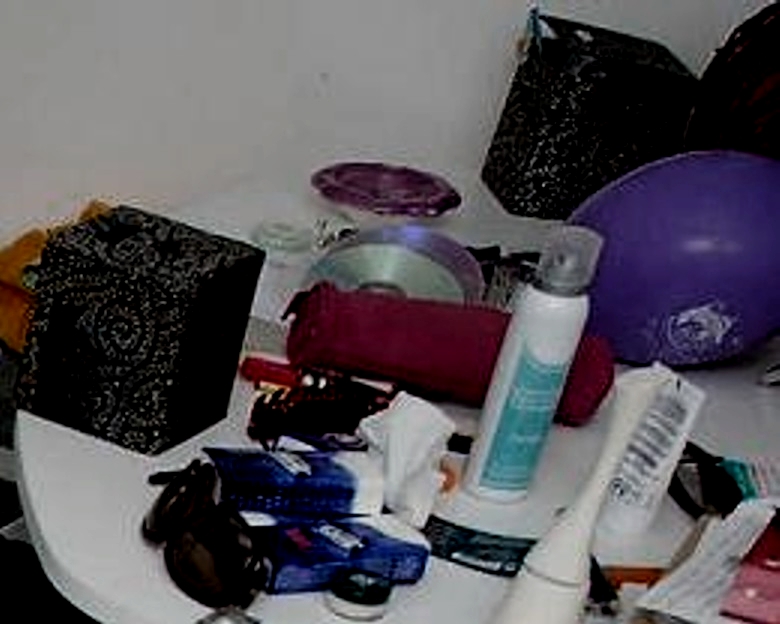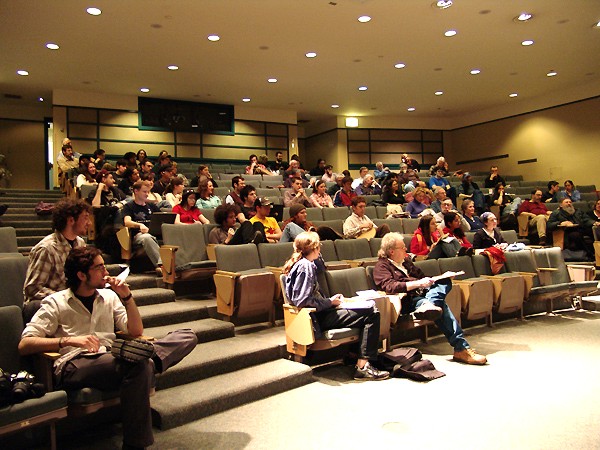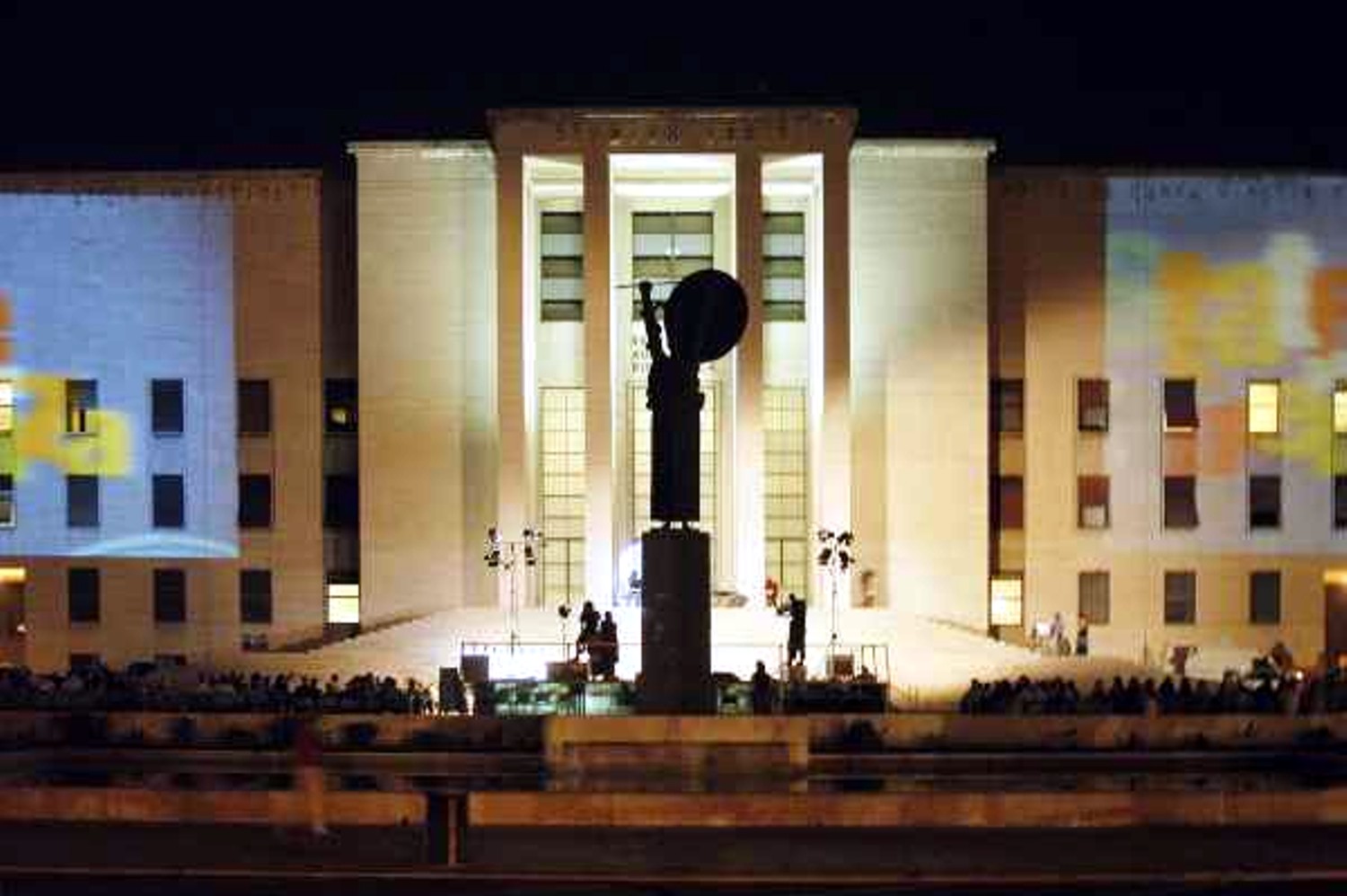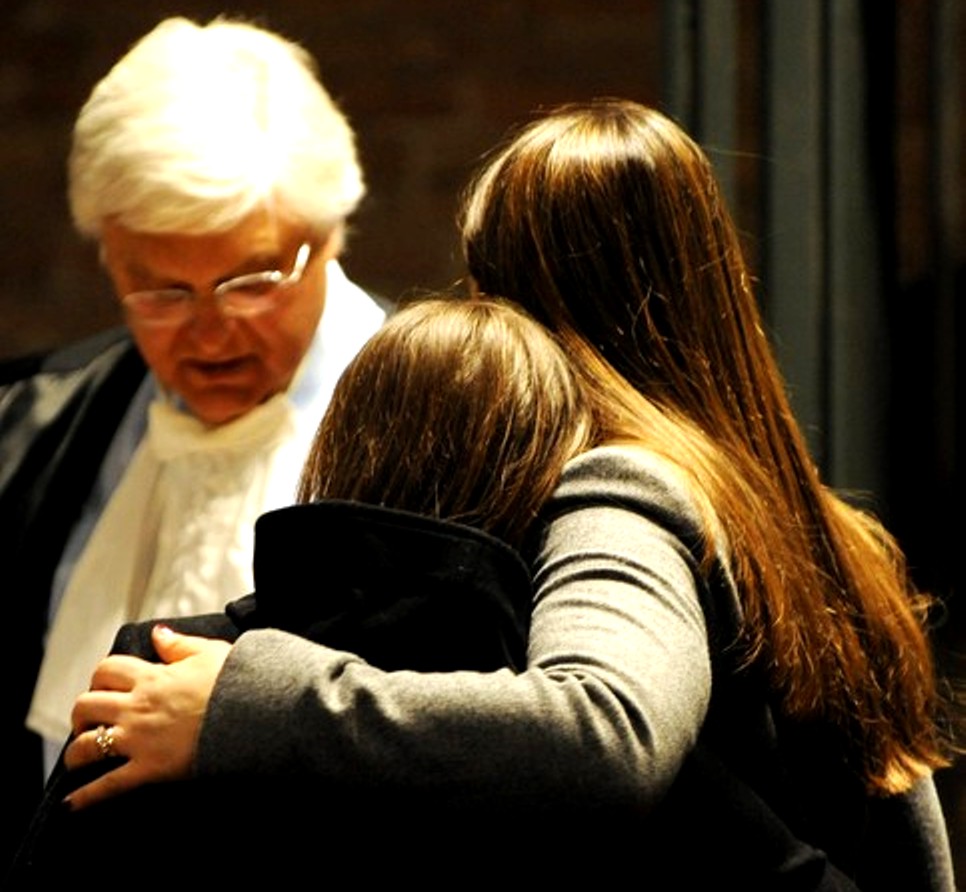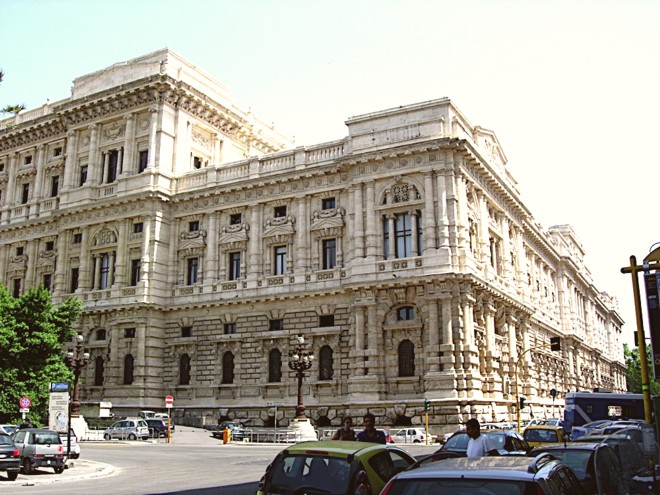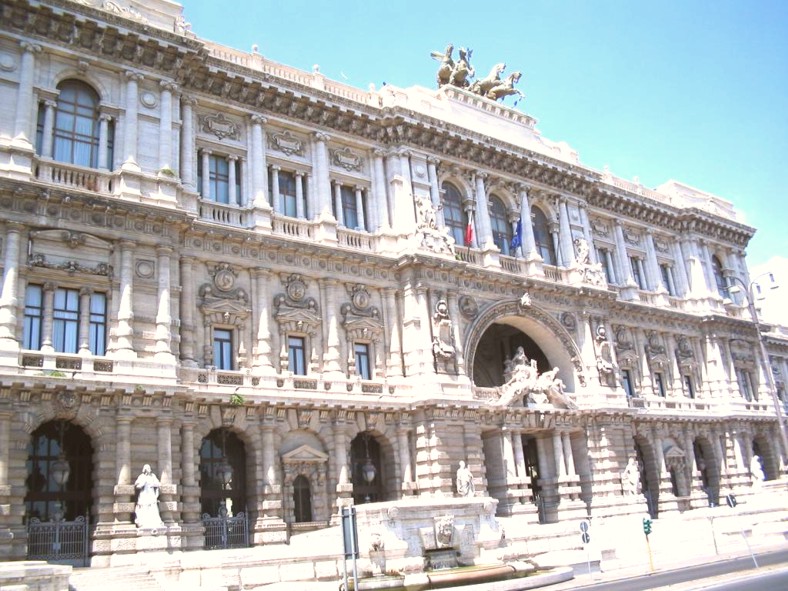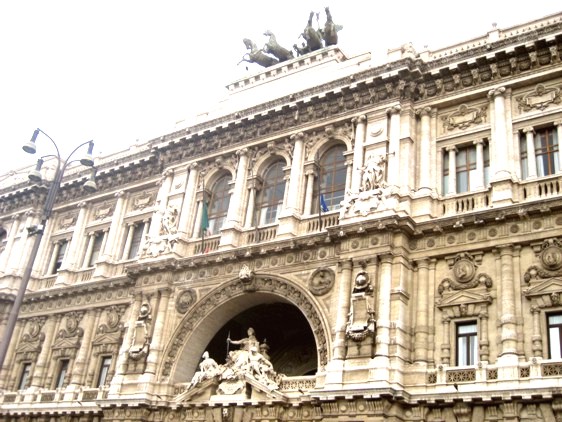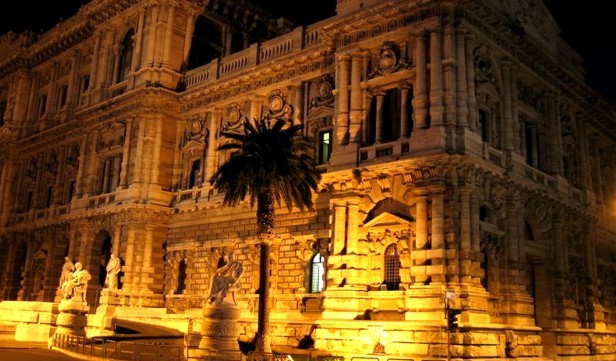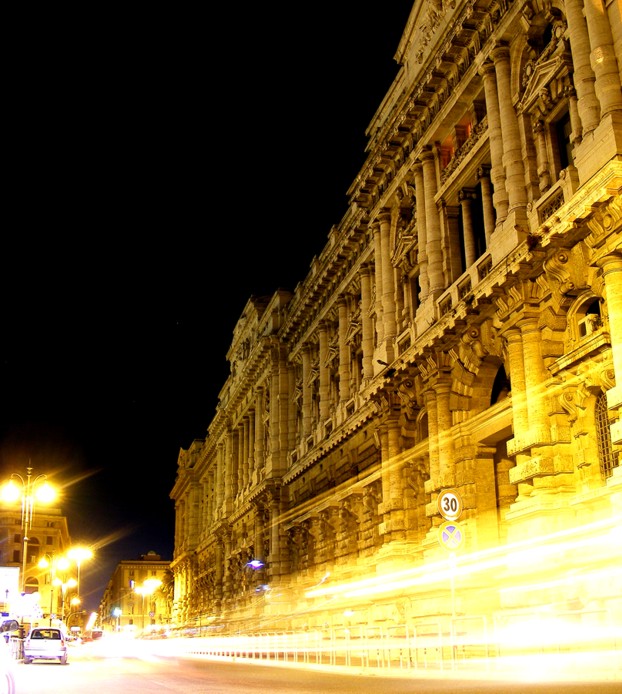
Friday, February 04, 2011
Lifetime TV Appear To Have Lied And Invented False Facts For Their Horrific Knox TV Movie
Posted by Peter Quennell
These are all of our previous posts on this hapless film, which defense lawyers had said they might sue to be put on ice until after the appeals are all done.
There seems to be growing outrage in the media (read the many angry comments down below there) over what seems the sensational promotion and the offensive and misleading content of the film.
The film was made in Milan and Rome and it is due to air in the US on Monday 21 February, and thereafter in various other countries around the world. .This is the film that both Arline Kercher and John Kercher had spoken out very strongly against. It appears from the trailer and the still images to contain various manufactured scenes seemingly designed to enhance Knox.
1) This scene at the top certainly did NOT take place, as Sollecito and Knox bizarrely chose to go for a pizza rather than join the grieving crowd at the memorial service for Meredith.
Among all who knew Meredith who were still in Perugia, they were the ONLY ones to refuse to attend. Neither Knox nor Sollecito have ever shown genuine sympathy for Meredith or for her family and friends.
2) This scene idepicts Meredith in an amorous position on top of Rudy Guede. This did NOT take place. Neither the Micheli court NOR Guede’s two appeal courts NOR the Massei court accepted that. Four courts rejected it as a lie and a defamation of the victim.
If Meredith were still alive, this would certainly be defamatory. Meredith had a headache that night and was tired after staying out most of the night before (Halloween), and she intended to finish a homework assignment and go to bed. She already had a boyfriend that she liked, and unlike Knox had zero history of sleeping around.
3) Lifetime told Meredith’s father John and many others in a public statement (they have never ever been in touch with the family quietly and directly) that the film would NOT depict the crime against Meredith, regardless of what angle Lifetime took toward Knox. The timeline would stop short of that.
And yet this scene show Meredith being savagely attacked by three people - exactly what Meredith’s family had feared most.
Right after the movie, Lifetime will apparently give the Knox-Mellases a full hour to sell their usual self-serving fabrications and half-truths.
And meanwhile, still not one word from Lifetime for the family of the real victim. Lifetime is a smallish network with a mostly elderly female demographic, and it mostly focuses with varying sympathy on women who have been hurt or killed. The REAL victims.
So what happened here?
Tuesday, February 01, 2011
Explaining The Massei Report: A Visual Guide To The Faked Break-In Via Filomena’s Window
Posted by pat az
1. Post Overview
Cross-posted from my own website on Meredith’s case at the kind invitation of TJMK.
The Massei Report on the trial and sentencing of Amanda Knox and Raffaele Sollecito looks into whether or not a break-in is supported by the evidence available in the room with the broken window.
It concludes that the broken window and room in disarray - Filomena’s bedroom - are an “artificial representation”, ie. that the break-in was faked. After seven pages of review of the evidence, the Massei Report states:
“the situation of disorder in Romanelli’s room and the breaking of the window pane constitute an artificial representation created in order to orient the investigations towards a person who, not having the key to the front door, was supposed to have entered through the previously broken window and then effected the violent acts on Meredith which caused her death.
What follows is a look at the comments in the Massei report compared with crime scene and other photos. All quotes are from the English translation prepared by unpaid volunteers at PerugiaMurderFile.org. The section on the scenes in the bedroom begins on page 47 and continues to page 55. Some sentences in the paragraphs below have been omitted for brevity, and can be read in full in the original.
2. Knox Finds The Scene
Then (Amanda) went into another room and noticed that the window had been broken and that there was glass inside. She told these things to her and the other girls present. Then she related that she had gone back to Raffaele’s house and had rung Filomena.
I)n one of the telephone calls to Romanelli, Amanda spoke of that smashed window and of the possibility that someone could have entered the house through the broken place; she said this also in the telephone call to 112 and in the first declarations to the Postal Police.
Also in the e-mail of November 4, 2007, sent by Amanda to 25 people in the US, she hypothesises that a burglar could have entered the house and says she looked around to see if anything was missing.
Filomena Romanelli, disturbed by this phone call, had rung Amanda back without receiving a reply and when, a little later, she had succeeded in speaking to Amanda, Amanda had told her that in her room (i.e., in Ms. Romanelli’s room) the windowpane was broken, everything was in a mess, and that she should come back home.
Filomena Romanelli had ascertained from a quick check of her room, even though (it was) in a complete mess with the windowpane broken, that nothing was missing.
It must be held that when Filomena Romanelli left the house in via della Pergola, she had pulled the [interior] shutters towards the interior of her room, although she did not think that she had actually closed them; furthermore, because they were old and the wood had swelled a bit, they rubbed on the windowsill; to pull them towards the room it was necessary to use some force (“they rubbed on the windowsill”); but in this way, once they had been pulled in, as Romanelli remembered doing, they remained well closed by the pressure of the swelled wood against the windowsill.
It cannot be assumed - as the Defence Consultant did - that the [interior] shutters were left completely open, since this contradicts the declarations of Romanelli, which appear to be detailed and entirely likely, considering that she was actually leaving for the holiday and had some things of value in her room; already she did not feel quite safe because window-frames were in wood without any grille.
Also, the circumstance of the [interior] shutters being wide open does not correspond to their position when they were found and described by witnesses on November 2, and photographed (cf. photo 11 already mentioned).
Now, for a rock to have been able to break the glass of the window without shattering the outside shutters, it would have been necessary to remove the obstacle of the shutters by opening them up.
Consequently, since the shutters had been pulled together and their rubbing put pressure on the windowsill on which they rested, it would have first been necessary to effect an operation with the specific goal of completely opening these shutters.
The failure to find any instrument suitable for making such an opening (one cannot even see what type of instrument could be used to this end) leads one to assume that the wall would have to have been scaled a first time in order to effect the complete opening of the shutters, in order to enable the burglar to aim at the window and smash it by throwing a large stone - the one found in Romanelli’s room.
He would then have to have returned underneath Romanelli’s window for the second climb, and through the broken glass, open the window (balanced on his knees or feet on the outside part of the windowsill), otherwise he would not have been able to pass his arm through the hole in the glass made by the stone) and reach up to the latch that fastened the window casements, necessarily latched since otherwise, if the casements had not been latched, it would not have been necessary to throw a rock at all, but just to open the shutters and climb inside.
The “climber” would also need to rely on the fact that the [interior] shutters were not actually latched, and also that the “scuri” ]blackout blind] had not been fastened to the window-frame to which the broken pane was attached; otherwise it would not have been possible to open them from the outside; nor would it have been possible, even breaking the glass, to make a hole giving access to the house, since if these inner panels had been closed, they would have continued to provide an adequate obstacle to the possibility of opening the window, in spite of the broken pane.
This scenario appears totally unlikely, given the effort involved (going twice underneath the window, going up to throw the stone, scaling the wall twice) and taking into account the uncertainty of success (having to count on the two favourable circumstances indicated above), with a repetition of movements and behaviours, all of which could easily be seen by anyone who happened to be passing by on the street or actually coming into the house.
But beyond these considerations, there are other elements which tend to exclude the possibility that a burglar could have entered the house through the window of Romanelli’s room.The double climb necessary to attain the height of three and a half metres would have left some kind of trace or imprint on the wall, especially on the points on the wall that the “climber” would have used to support his feet, all the more as both the witnesses Romanelli and Marco Zaroli gave statements indicating that the earth, on that early November evening, must have been very wet (..6) (p50)
In fact, there are no visible signs on the wall, and furthermore, it can be observed that the nail ““ this was noted by this Court of Assizes during the inspection ““ remained where it was: it seems very unlikely that the climber, given the position of that nail and its characteristics, visible in the photo 11, did not somehow “encounter” that nail and force it, inadvertently or by using it as a foothold, causing it to fall or at least bend it. (p50)
The next fact to consider is that the pieces of glass from the broken pane were distributed in a homogeneous manner on the inside and outside parts of the windowsill, without any displacement being noted or any piece of glass being found on the ground underneath the window.
This circumstance, as confirmed also by the consultant Pasquali, tends to exclude the possibility that the rock was thrown from outside the house to create access to the house through the window after the breaking of the pane. The climber, in leaning his hands and then his feet or knees on the windowsill, would have caused at least some piece of glass to fall, or at least would have been obliged to shift some pieces of glass in order to avoid being wounded by them.
Instead, no piece of glass was found under the window, and no sign of any wound was seen on the pieces of glass found in Romanelli’s room. It can moreover be observed that the presence of many pieces of glass on the outside part of the windowsill increases the probability of finding some small pieces of glass on the ground underneath, since there seems to be no reason that so many pieces of glass would all stop just at the edge of the windowsill without any of them flying beyond the edge and falling down to the garden below. (p51 & 52)
On this subject it is also useful to recall that at the hearing of April 23, 2009, the witness Gioia Brocci mentioned above declared that she had observed the exterior of the house, paying particular attention to the wall underneath the window with the broken pane, the window of the room then occupied by Filomena Romanelli.
She said: “We observed both the wall”¦underneath the window and all of the vegetation underneath the window, and we noted that there were no traces on the wall, no traces of earth, of grass, nothing, no streaks, nothing at all, and none [39] of the vegetation underneath the window appeared to have been trampled; nothing” (p. 142 declarations of Gioia Brocci). (51)
This situation, like all the other glaring inconsistencies, is adequately and satisfactorily explained if one supposes that the rock was thrown from the inside of the room, with the two shutters pulled inwards so that they blocked the pieces of glass from falling to the ground below. Once the glass had been broken from inside, the rock was set down at some place in the room, and the shutters were pushed towards the outside, being thus opened from within the room. (p51)
But the fact that all this was in fact just a simulation, a staging, can be deduced from further circumstances. From the photos taken by the personnel of the Questura (photos 47 to 54 and 65 to 66) one can perceive an activity which appears to have been performed with the goal of creating a situation of obvious disorder in Romanelli’s room, but does not appear to be the result of actual ransacking, true searching for the kind of valuable objects that might tempt a burglar.
The drawers of the little dresser next to the bed were not even opened (photo 51 and declarations of Battistelli who noted that Romanelli was the one who opened the drawers, having found them closed and with no sign of having been rifled: see p. 66 of Battistelli’s declarations, hearing of Feb. 6, 2009).
The objects on the shelves in photo 52 appear not to have been touched at all; piles of clothes seem to have been thrown down from the closet (photo 54) but it does not seem that there was any serious search in the closet, in which some clothes and some boxes remained in place without showing any signs of an actual search for valuable items that might have been there (photo 54).
It does not appear that the boxes on the table were opened (photo 65) in a search for valuable items. And indeed, no valuable item (cf. declarations of Romanelli) was taken, or even set aside to be taken, by the ““ at this point we can say phantom ““ burglar.
What has been explained up to now thus leads to the assertion that the situation of disorder in Romanelli’s room and the breaking of the window pane constitute an artificial representation created in order to orient the investigations towards a person who, not having the key to the front door, was supposed to have entered through the previously broken window and then effected the violent acts on Meredith which caused her death.
Footnotes
(...1) The Massei Report in English is readable and downloadable via the link at the top of this page.
(..2) The consultant for the defence actually assumed that this had been done; in his exhibit, he assumed that the shutters were not present in front of the window
(..3): “if the shutters were closed, he could not have passed through, that is obvious”, cf. declarations of the consultant for the defence, Sergeant Francesco Pasquali, p. 22 hearing July 3, 2009.
(..4): (the window in Romanelli’s room is located at a height of more than three and a half metres from the ground underneath, cf. photo 11 from the relevant dossier)
(..5):,which are the wooden panels [scuri=non-louvered shutters in interior of room] that usually constitute the outer side (or the inner, depending on the point of view) of the window [attached to the outer edge of the inner side of the window-frame]
Friday, January 28, 2011
Why Don’t Perpetrators Say They’re Sorry? A Psychoanalytic Perspective
Posted by Carol Poole

[Image: In downtown Leeds, a city in which Meredith was extremely happy]
A disclaimer: I do not intend these remarks as commentary on any specific individual(s). I’m offering them as food for thought, for anyone who (like me) struggles to understand both the human capacities for destruction and for healing
Why don’t abusers apologize when they’re caught? Even when it would be in their own best interest to show remorse?
Of course, there are exceptions. Sometimes people own their crimes and take responsibility. The less shameful the crime, the more likely this is. As Johnny Cash sang, “I shot a man in Reno/Just to watch him die.” When he sang at Folsom Prison, no doubt his audience nodded along, sharing a general sense that shooting or getting shot in a bar is the kind of thing that any man might find himself doing on a bad day.
But no one sings about molesting a child. Or rape. Even the Green River Killer, Gary Ridgway, was offended when officers suggested he had raped the women he murdered—women, most of them young, all of them working the hardest of jobs and deserving much better.
So there are some crimes that no one brags about—or apologizes for, either, which is a shame, since the survivors and loved ones are left to try to understand what has happened. In my work as a psychotherapist for trauma and abuse survivors, I seek answers for this difficult question: how can people do such terrible things to others, and show no remorse?
This is especially hard when the perpetrator seems like a nice, “normal” person, a respected member of society. We can more easily understand when an act of violence is committed by someone in the grip of a psychotic delusion. It’s just a terrible accident then, a case of being in the wrong place at the wrong time. Likewise, we don’t lose sleep trying to understand a coldly sociopathic attack: we don’t have to wonder why a mugger steals a purse.
But it baffles and hurts us deeply when someone we should have been able to trust commits violence against one of us. Especially when the crime is covered up by denial, adding injury to injury by robbing the injured parties of something they need in order to heal: acknowledgment of the truth of what’s happened.
Dori Laub, a psychoanalyst who survived a childhood in concentration camps in the Holocaust, observed that when our faith in goodness is shattered, we feel abandoned by the world of goodness, and lost in a kind of desert of the soul, a deathly state that feels empty of all life except for the malign presence of the perpetrator.
And he pointed out something he must have learned by experience: there is something about trauma that messes with our ability to recognize it when it’s happening. Our minds sometimes cannot see it, refuse to put together the picture that is right in front of our eyes, perhaps because we fear that if we see the truth, it will destroy our hope that the world is the good place we need it to be.
This, I believe, is why good people sometimes collude with abuse by refusing to see it. The refusal is happening at such a deep instinctive level that it’s rarely an entirely conscious choice.
And in a sense, it’s also why perpetrators of the worst crimes so rarely own what they’ve done. Research has shown that abusers have a curious relationship with remorse: they may have formidable defenses against feeling guilt, which is feeling bad about what you’ve done. But they are highly prone to shame, which is feeling bad about who or what you are.
The kind of people who are most likely to abuse others are those who are absorbed by a damaged sense of self. They lash out in a crude effort to fend of feelings of being bad, in a kind of magical thinking: If I put the badness in you, it won’t be in me anymore. If I make you hurt, then I won’t have to hurt. To a very childish state of mind, to hurt is to be bad. We all make that equation when we’re very small, but most of us grow a mature sense of self that integrates our many different feelings into a whole picture.
Having a mature sense of self means being able to say, “I sometimes do things that aren’t good. I wish that wasn’t true, but it is. At least I can try to repair the harm I’ve done, and learn not to do it again.” The same sense of integration is what prevents us from acting out our worst impulses. We can safely want to strangle people from time to time, knowing we will never do it.
When someone’s sense of self is so badly damaged that they can be violently abusive, they aren’t able to hold together a whole story about themselves, or about what they’ve done. It’s only after years of therapy (or other means of growth) that such a person might become able to really put together the picture of their own violence, and take responsibility for their actions.
Which means that people who have been harmed by violence have to find ways to take care of themselves and heal, even though the perpetrator has an infuriating, baffling way of seeming not to have been there at all. It’s as though nothing happened.
It’s natural to wish that the perpetrator would be sorry. It would help so much to hear their apology. But there’s a trap, too, in waiting for help from that quarter. It’s no good trying to get such a person to hear you or understand that gravity of what they’ve done. It’s like trying to get a clear reflection out of the fragments of a shattered mirror.
Instead, what helps survivors and loved ones heal is to tend their souls, and work their way back toward everything that makes life full: love, trust, gratitude, hope. Which means finding a way to grieve the losses.
We don’t grieve in the cold shadows of the death zone; we grieve when we remember our love and our hope for the future.
It helps to have a sense of community acknowledging our loss. It helps if we can find a way to bring something good out of the devastation—if we can at least bring some meaning to the loss by letting the tragedy inspire us to do good.
It’s only at the end of the movie, when the mother and child embrace, that we can let down and weep for everything they had to go through to find each other again, and weep too for the ones we miss.
Thursday, January 27, 2011
Today’s New York Times: Record Level of Stress Found in US College Freshmen
Posted by Peter Quennell
Front page headline in the paper edition of the NY Times today includes this.
Campus counselors say the survey results are the latest evidence of what they see every day in their offices “” students who are depressed, under stress and using psychiatric medication, prescribed even before they came to college.
The economy has only added to the stress, not just because of financial pressures on their parents but also because the students are worried about their own college debt and job prospects when they graduate…
“Most people probably think emotional health means, “˜Am I happy most of the time, and do I feel good about myself?’ so it probably correlates with mental health,” said Dr. Mark Reed, the psychiatrist who directs Dartmouth College’s counseling office.
“I don’t think students have an accurate sense of other people’s mental health,” he added. “There’s a lot of pressure to put on a perfect face, and people often think they’re the only ones having trouble.”
Sadly, probably a few time bombs in there that might one day go off. And nobody around them will notice, or at least act to prevent. Tough problem. Taking the correct measures to get the so-called economy to work might help. Kids are being incredibly under-served.
Today also, an especially gloomy report came out about the future of European economies with one or two expected to default. Even the New York Times itself may not survive.
Wednesday, January 26, 2011
Letter From Italy: Explaining Why My Pro-Women-Victims Focus In My Forthcoming Movie Samhain
Posted by Stefano Torrese
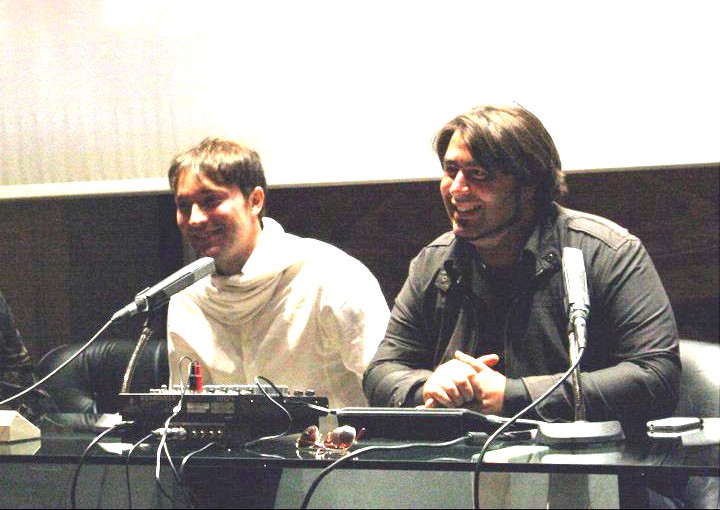
[Above: Stefano Torrese (right) and his co-author and co-producer Diego Antolini discuss Samhain]
While reading Mr. Kercher’s open letters [here and here] we found so many resonances with our ideas and feelings about the sad drama that occurred to Meredith, feelings which had led us to initiate the film project “Samhain - A Halloween Tale”.
Our starting point was to write a story which could deliver a strong message on behalf of all women whose life had ended because of the violence and ignorance of others; to provide our contribution to making people think and re-think about the society we live in, where nobody is safe, children or students or workers.
Then, as we deepened the research into the subject, and more material came out about the judicial case and the trials, we witnessed, as John sadly remarked, a singular yet logical - for our society - phenomenon, that of the rising of a celebrity, who is in fact charged for murder and sentenced to many years in prison.
Last spring we started to see the first buzz in the US about our movie project and those of others. A few months later we heard the inevitable: an American TV production decided to shoot a documentary about AMANDA KNOX’S trial paths.
As fall approached, we trimmed and refined our story into a thriller with a moral, and a big, positive twist in the end, which developed furthermore a strong message. This message we made clear during our first press conference on last October 28, in the Palazzo della Regione of Perugia, the most important institutional house of local government.
We said that our movie is not - and will never be - a movie about Amanda Knox; as a matter of fact it is not even a movie about Meredith in the sense of the exploitation of her image for economic purposes.
“Samhain - A Halloween tale” is a tale with a moral in the classical form, inspired by a true fact (obviously Meredith’s murder) but then touching many other topics like the very ancient celtic name of Halloween “Samhain”, the possibility to mold the timeframe, and other esoteric elements.
The story turns around former FBI agent Bryan Nolan, who left the US following the personal drama of the disappearance of his little sister Susan.
Once in Perugia, he hears about the murder of a young student and after a series of signs and signals, he realizes the spirit of the young girl is trying to establish contact with him; the spirit seeks for peace and justice, and it is also the key to understand what really happened to Bryan’s sister.
As you can tell from this brief synopsis, our story doesn’t contain the Hollywood-like sparkling and kitsch elements prone to making the protagonist a star or a celebrity. Our movie is difficult, and will be difficult to make because it talks about life, death, and the afterlife.
During the last few months we have received pressure from local and international press about what we really want to make, and so we wanted to be clear: if our movie has ever to be linked to Meredith, it would be in her honor, dedicated to her memory, and it would not use her image.
We said this after noticing the hideous growth in terms of popularity of people who are in jail for murder, and yet became a money machine, and also the attitude of the general audience who are being misled and manipulated into the belief that these people in jail shouldn’t be there.
This shocked us and prompted our more immediate action: we can write and we can make movies, so we will make our contribution to the truth by the means of telling a story and deliver a message to the audience:
A GIRL WAS MURDERED, DIED, AND NOT ONLY HER BODY BUT HER MEMORY IS ABOUT TO BE BURIED AND NEVER COME OUT TO LIGHT AGAIN.
We cannot accept that, what happened to Meredith happened - and is happening - to many other girls in the world. We need to remember this. We need to remember Meredith and through her memory, keep this feeling of hope alive, that what happened to her will eventually cease to happen.
We need to disseminate the message as strongly as we can, and perhaps things could change so that Meredith’s drama would not have occurred in vain.
Our hope here is to respectfully share with Meredith’s family and friends an explanation of what’s behind our project, let them know what we are doing before they read it possibly wrongly put in the papers; and encourage their feelings if they wish to guide us.
A good project about a person without deep caring and respect for that person - be she alive or not - would be a failure to begin with. Meredith evokes our deep caring and respect.
[Below, Stefano Torrese and his co-producer Diego Antolini discuss the Italian film industry]
[Below, the interim trailer for Stefano Torrese’s movie Samhain: A Halloween Tale]
[Below, the poster for Stefano Torrese’s movie Samhain: A Halloween Tale]
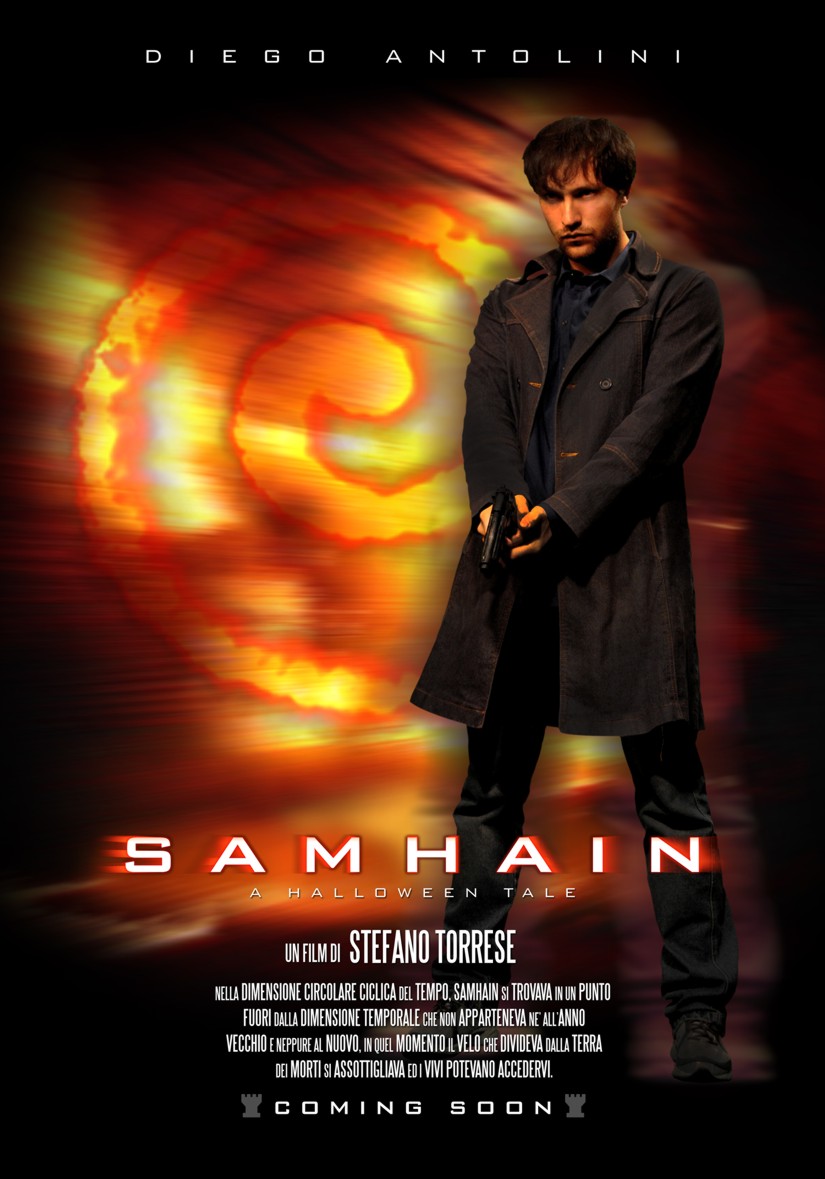
Monday, January 24, 2011
The Limited DNA Reviews - What We Believe Are The Hard Facts On The Double DNA Knife
Posted by ViaDellaPergola
Repeat of my December post as the knife is again back in sharp focus.
The wild claims of the conspiracy theorists have morphed back and forth. But the facts remain that Italy has a fine DNA lab system and Dr Stefanoni is internationally respected - and she had no vested interest in a particular outcome.
Sollecito coolly explained that Meredith’s DNA SHOULD be on the blade of the knife because he pricked her while he was cooking a fish at his place. She had never ever been to his place - in fact, she had only set eyes on him once or twice, very briefly, and had certainly not eaten his fish.
But Sollecito STILL lets that highly incriminating statement stand - one that is enough to secure a conviction in an American court all by itself. Sollecito never retracted or explained it. Why not? Why not?
The truth, obviously, is worse. Very, very much worse.
Sunday, January 23, 2011
Andrea Vogt Reports Chris Mellas To His Credit Throwing The Conspiracy Theorists To The Wolves
Posted by Peter Quennell
Click above for another excellent Seattle PI report. It says the prosecution did not want to break open the knife. It also includes this.
Chris Mellas told seattlepi.com in a courtroom break… that three additional experts—two Americans and one woman living in Australia—are also contributing behind the scenes.
“We have had a lot of people want to help just for their own notoriety, but these are people who have a lot of resources and who want to help for the right reasons,” Mellas said.
Sounds like a smart and timely move. They do need a few people from Planet Earth.
Saturday, January 22, 2011
Fourth Appeal Hearing: Updates On Today’s Court Hearing Which Is Mainly Procedural
Posted by Peter Quennell
Above: Sapienza University is the largest European university and the oldest of Rome’s three state-funded universities.
- At noon Italian time ANSA reported that the two DNA experts from Sapienza University have been given 90 days to do their retesting. They will begin their review on Feb. 9, conclude by May 9 and report their findings to the court on May 21.
- The witness in the square on the night who said he saw Sollecito and Knox, Antonio Curatolo, will be re-examined. This is at the prosecution’s request, not at the defenses’.
- The DNA experts have asked to break open the handle of the knife they are asked to retest. If Meredith’s blood is found to have seeped into the handle, by itself that will be case closed and verdict confirmed. Decision on hold.
- The examinations will be carried out in the presence of representatives of all parties. Among them will be Dr. Patrizia Stefanoni, the technical director of the forensic laboratory that conducted the original DNA investigations.
- The prosecution requested Rudy Guede as a witness and that too was put on hold. Yet another shot across the bows of the defense. If Alessi or Aviello are put on the stand then Guede will also be there to heatedly rebut them.
- The next appeal hearings scheduled by the court of appeal have been set for 12 and 26 March, and April 16 and May 21. May 21 is when the DNA experts will report back so just three days for examination of witnesses.
Judge Hellman is allowing no defense fishing expeditions, and he is giving the prosecution full latitude. Good reason for Giulia Boingiorno not to be in court: her baby was delivered today in Rome. We like her and wish her and the baby well.
Below, images of the two court-appointed DNA experts and of Amanda Knox. The Reuters caption says her lawyers are consoling her. Chris Mellas’s remarks later made it sound like the family is already trying to let her down gently.
.
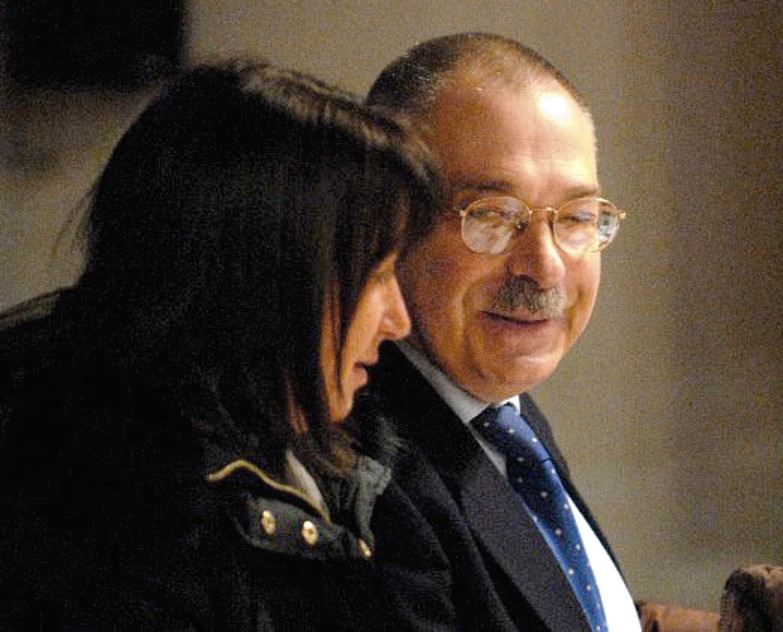
The Fourth Appeal Hearing Today Saturday: The Main Items On The Court’s Agenda
Posted by Peter Quennell
Not very much drama is expected. This hearing is mainly organizational.
The mood of the defense lawyers will be interesting to watch. Also whether Sollecito lawyer Giulia Bongiorno is a show or a no-show. And we may find out if the possible defense witnesses Mario Alessi and Luciano Aviello will actually testify.
Two DNA experts nominated by Judge Hellman at the last appeal hearing on 11 December for the genetics testing of the bra clasp and the knife will appear and be sworn in and charged with their assignment.
Stefano Conti and Carla Vecchiotti of La Sapienza University in Rome will be asked how long they believe they will need and it is expected that they will ask for two to three months.
And the court will establish a timetable for the testimony of several new defense witnesses who may challenge one or two components of Antonio Curatolo’s statement. Nick Pisa bizarrely mis-reports on this in the Daily Telegraph:
He had told the court he remembered the night “clearly” as he saw student revellers queuing up to catch buses to nightclubs on the outskirts of the city.
However defence lawyers have established that he could not have seen the students, as the night Meredith was murdered was a bank holiday with venues being shut and no buses running.
Have established that he could not have seen the students? Really? There were other buses than the disco buses running that night. Students were definitely around.
If prisoners Mario Alessi or Luciano Aviello are indeed put on the firm list to testify that’ll be a pretty sure sign that the defenses are really clutching at straws, as in each case their known claims are contradicted by dozens of evidence points .
The prosecution has interviewed both of them and those interviews have not been made public. Here are more wrong and seemingly irrelevant claims bizarrely reported by Nick Pisa.
Retired British university professor David Anderson, who lives near Perugia and who has taken an interest in the case, said: “The conviction of Amanda and Raffaele is scandalous as neither has the psychological profile of a killer.
“The investigation was flawed from the beginning with many mistakes being made and there is no DNA, no real motive, no weapon and no credible witnesses at all.”
Thursday, January 20, 2011
The New 80,000 Pound Gorilla In The Room Introduced By The Italian Supreme Court
Posted by Our Main Posters

[St Peter’s and the Vatican in background; Palace of Justice, large white building by river in left foreground]
What is the biggest headache for the defenses?
That their areas of appeal, already circumscribed by Judge Hellman, could all explode in their faces? The low-credibility witnesses Alessi and Aviello? The limited DNA retesting? The re-examination of the witness in the park who had no cause to make anything up?
Or that Rudy Guede gets totally ticked off by Alessi’s claims that Rudy Guede said he did it with one or two others, and so Guede tells the court all that REALLY happened?
No, it looks to us that the defenses’ biggest headache by far is that the court of final appeal in Rome (the Supreme Court of Cassation, which is superior to the Perugia appeals court and will hear the second and final appeal) has ALREADY accepted that Rudy Guede’s sentencing report of January 2009 holds up.
And that all three of them attacked Meredith.
The written report from Cassation on that December 2010 decision on Guede’s final appeal (due soon), plus Judge Micheli’s Sentencing Report for Rudy Guede of January 2009, plus all that associated evidence, now gets automatically ported by law straight into Knox’s and Sollecito’s appeal.
Judge Micheli took a hard line toward Rudy Guede, and he sentenced him to 30 years. He also remanded Knox and Sollecito to trial, and his report explains the basis for that remand.
Judge Micheli’s remorseless and tightly argued report (see summaries below) very comprehensively backed up his decisions. (Later reductions in sentence were automatic and they flowed from the terms of Guede’s short-form trial, and some controversial mitigating circumstances advanced by Massei for Knox and Sollecito.)
The prosecution’s appeal against the Knox and Sollecito sentences argues that the acceptance of mitigating circumstances by the Massei court should be thrown out, and that Knox and Sollecito should be subjected to a longer sentence. Remember that even in the case of Alessi’s wife, who was not even present when he beat the kidnapped baby to death, she received a sentence of 30 years.
So here is how it is stacking up:.
- For the prosecution, four courts including the Supreme Court of Cassation have ruled that three people participated in the crime against Meredith, plus all of the evidence from both the Guede and Knox Sollecito trials now comes in, plus the prosecution is appealing for tougher sentences, which seems well justified based on precedents.
- For the defenses, just those few areas the defenses want to challenge which have been allowed by Judge Hellman NONE of which are sure things.
Really not very much going for the defenses here. No wonder they already seem to be phoning it in.
Our meticulous summaries of the Micheli Report by main posters Brian S and Nicki were based on our own translation. A huge amount of work. They were posted nearly two years ago. Periodically we link to them in other posts or we point to them in an email.
Those who do read those posts fresh are often stunned at their sharpness, and for many or most it becomes case closed and the verdict of guilty is seen as a fair one.
We think those posts on Micheli are so key to a correct grasp of Knox’s and Sollecito’s appeal prospects that they should now be reposted in full.

[St Peter’s and the Vatican in foreground; Palace of Justice, large white building in left background]
Understanding Micheli #1: Why He Rejected All Rudy Guede’s Explanations As Fiction
By Brian S
Judge Micheli has had two very important roles. He presided over Rudy Guede’s trial and sentencing, and he presided over the final hearing that committed Raffaele Sollecito and Amanda Knox to trial.
A week ago, just within the three-month deadline, Judge Micheli made public the 106-page report that explains the thinking behind both actions. This is a public document, and in the enviable Italian legitimizing process, the public is encouraged to get and read the report and to understand the full rationales. Excellent analyses have already appeared in Italian in Italy, but no English-speaking sources on the facts of the case have either put the report into English or published more than the most superficial analysis.
These posts will examine several very key areas of the report so that we too may choose whether to buy into the rationales. The translations into English here were by native-Italian speakers and fellow posters Nicki and Catnip. The next post will explain why Micheli ruled out the Lone Wolf Theory, and why he concluded that Knox and Sollecito appeared to be implicated in Meredith’s murder and should therefore be sent to trial.
Judge Micheli maintained that from the moment Meredith’s body was discovered until his arrest in Germany on November 19th, Rudy Guede was in a position to compile a version of his involvement in events at the cottage which would minimise his reponsibilities and point the finger of guilt elsewhere.
He was able to follow the course of the investigation in newspapers and on the internet. He would know of the arrests of Amanda, Raffaele and Patrick. He would know that the investigators had found biological evidence which would sooner or later connect him to the murder, and he would know of other discoveries and evidence which had been publicised in the media.
His story as told in Germany was compiled with all the knowledge about the crime and investigation he would have sought out. On his return to Italy in December he was interviewed by the investigating authorities and gave version 2. He was interviewed again in March which resulted in version 3, and later still made a spontaneous statement to change one or two facts including the admission that the trainer footprint in Meredith’s room could be his. Judge Micheli said:
- Analyzing the narratives of the accused…he is not credible, as I will explain, because his version is (1) unreliable, and (2) continuously varying, whether on basic points or in minor details and outline.
Micheli then examined the details of Rudy’s claimed meeting with Meredith which resulted in his invitation to the cottage on the evening of November 1st.
He noted there were substantial differences between his versions of December and March, particularly with regard to the location of his meeting with Meredith on the night of Halloween and his movements in the early evening of November 1st.
He considered it likely that Rudy had made these changes as he became aware of evidence which contradicted his December version. Notably, in December Rudy claimed to have had his meeting with Meredith which resulted in her invite at a Halloween party given by Spanish students.
By March it was well known that Meredith had spent her entire Halloween in the company of friends, first in the Merlin pub before they later moved on to Domus disco. In March Rudy changed the location of his meeting with her from the Spanish party to Domus, which by chance Rudy had also attended following the party. However, neither Meredith’s friends who were continuously in her company nor those who accompanied Rudy to the Domus witnessed any meeting between the two. Judge Micheli commented:
- On 26 March 2008, instead, Rudy explained to the Prosecution, drawing a picture, that the group invited to the Spaniards’ house actually moved wholus-bolus to the “Domus” club, but it was right in that nightclub that he met Kercher, and not before; offering up a tour-guide description from the chair, saying, “there’s a bar for the drinks and then there’s a room, there’s an arch and a room. I walking [sic] around there, and that’s where I met Meredith”. On the facts of the meeting and the subject of the conversation, he elaborated: “I started talking to Meredith “¦talking anyway I gave her a kiss.. after which I told her how much I liked her and asked her if the next day, in all the confusion anyway, if we were going to meet the next day and she said yes (”¦), we met in the evening around half eight, like that.
While not intending to explore the question, basically irrelevant, of whether the pair had agreed to a more or less specific time (his confirmation of the suggestion of 8.30 pm in both verbal statements however allows the inference that according to Guede they had an appointment), the patent contradiction between the two versions jumps out. One context, of a room between two bathrooms, in an apartment, is completely different to that of a drinks-bar and an arch, in a pub; one might concede, perhaps, the possibility of forgetting which place it was where they last bumped into a friend, but hardly the first time there was a kiss with a girl towards whom one was attracted.
With regard to his movements in the early evening of November 1st, Rudy’s friend Alex failed to corroborate Rudy’s December claim to have visited his flat. He said he didn’t see Rudy either before or after his meeting with Meredith at her cottage.
In March, Rudy changed his story and claimed to have risen at 6pm(following the all-nighter at Domus) before wandering around town for an hour or so. He then said he went to Meredith’s cottage but received no answer so he carried on to Piazza Grimana in the hope he might see people he knew. He thought he arrived in the Piazza at around 7:30pm. He claimed that some time later he left Piazza Grimana and called at the Kebab shop before returning to Meredith’s cottage and arriving some time between 8:30 and 9:00pm.
He said he then waited until her arrival some time just after 9:00pm. It was noted that in both his December and March versions Rudy said he had arranged to meet Meredith at 8:30pm. Micheli noted that this didn’t sit well with another arrangement Rudy had made to meet Carlos (from the Spanish party) between 9:00 and 10:00pm.
Micheli said that neither version of Rudy’s movements could be treated as true because he changed his story to fit facts as they became known and there was absolutely no corroborating witness evidence.
Rudy claimed two situations evolved following his entry with Meredith into the apparently empty cottage:
Whilst he was having a drink of fruit juice from the fridge, he claims Meredith found that 300 euros (her rent money) was missing from her bedside cabinet. Meredith was naturally upset by this discovery and straight away blamed “druggy Amanda”. Rudy said they both checked Amanda’s room to see if the money was there. However, it couldn’t be found and Rudy sought to console her.
He says that this consolation developed into an amorous encounter which proceeded to the stage where “Meredith asked him” if he had a condom. He told he didn’t and since she didn’t either they stopped their lovemaking.
Judge Micheli had a real problem with this story as told by Guede. He found it unlikely that Meredith would be interested in lovemaking so soon following the discovery that her money was missing. He found it unlikely that it was Meredith who was leading the way in this amorous encounter as Rudy was suggesting with his claim that it was “Meredith who asked him” if he had a condom.
Surely, Micheli reasoned, if Rudy was hoping to indulge in a sexual encounter with Meredith following the previous night’s flirting, he would, as any young man of his age, ensure that he arrived with a condom in anticipation of the hoped for liason. But even if he didn’t, and it was true that events had reached the stage where Meredith asked him, then surely given his negative response, Meredith would have again gone into Amanda’s room where, as she had told her friends, condoms were kept by her flat mate. Judge Micheli simply didn’t believe that if they had got to the stage of lovemaking described by Rudy, and following his negative response to her question, they just “STOPPED”. Meredith would have known she had a probable solution just metres away.
Rudy claimed he then told Meredith he had an upset stomach because of the kebab he had eaten earlier. She directed him to the bathroom through the kitchen.
Rudy put on his i-pod and headphones as he claimed was his habit when using the toilet. In his December version Rudy said the music was so loud he heard the doorbell ring but he made no reference to hearing any conversation. A perfect excuse, Judge Micheli says, for not hearing the disturbance or detail of Meredith’s murder. However, in his March version he claims he heard Amanda’s voice in conversation with Meredith. When Rudy did eventually emerge from the bathroom he says he saw a strange man with a knife and then a prone Meredith. Micheli commented:
- ...it is necessary to take as given that, in this case, Kercher did not find anything better to do than to suddenly cross from one moment of tenderness and passion with him to a violent argument with someone else who arrived at that place exactly at the moment in which Rudy was relieving himself in the bathroom. In any case, and above all, that which could have been a surprise to the killers, that is to say his presence in the house, was, on the other hand, certainly not put into dispute:
Meredith, unlike the attackers, knew full well that in the toilet there was a person who she herself allowed in, so for this reason, in the face of someone who had started raising their voice, then holding her by the arms and ending with brandishing a knife and throwing her to the floor, why would she not have reprimanded/reproached/admonished him immediately saying that there was someone in the house who could help her?
“¦Meredith didn’t shout out loudly for Rudy to come and help
“¦There was a progression of violence
“¦The victim sought to fight back
If it is reasonable to think that a lady living 70 metres away could hear only the last and most desperate cry of the girl ““ it’s difficult to admit that Guede’s earphones, at 4-5 metres, would stop him hearing other cries, or the preceding sounds.
Micheli was also mystified as to why Amanda (named in Rudy’s March version) would ring the doorbell. Why wouldn’t she let herself in using her own key? He supposed it was possible Meredith had left her own key in the door which prevented Amanda from using hers, but the girls all knew the lock was broken and they were careful not to leave their own key in the door. Perhaps, Meredith wanted some extra security/privacy against someone returning and had left her key in the lock on purpose. Maybe Amanda was carrying something heavy and her hands weren’t free. Or, maybe, Rudy was just trapped by his December story of the doorbell when he didn’t name anybody and an anonymous ring on the doorbell was plausible.
The judge then took issue with Rudy’s description of events following the stabbing of Meredith. Rudy claimed that when he emerged from the bathroom he discovered a man with a knife standing over Meredith. In the resultant scuffle he suffered cut wounds to his hand. armed himself with chair to protect himself. before the attacker fled when he fell over because his trousers came down around his ankles. Micheli said that those who saw Rudy later that night didn’t notice any wounds to Rudy’s hands although some cuts were photographed by the police when he was later arrested in Germany.
Micheli found Rudy’s claim that the attacker ran from from the house shouting “black man found, black man guilty” unbelievable in the situation. In the panic of the moment it may be conceivable that the attacker could shout “Black man…, run” following the surprise discovery of his presence in the house, but in the situation Rudy describes, blame or expressions of who the culprit thought “the police would find guilty” made no sense. It would be the last thing on an unknown attackers mind as he sought to make good his escape.
Micheli considers the “black man found, black man guilty” statement an invention made up by Rudy to imply a possible discrimination by the authorities and complicate the investigation. Micheli also saw this as an excuse by Rudy to explain away his failure to phone for help (the implication being that a white man could have made the call). It was known by her friends and acquaintances that Meredith was never without her own phone switched on. She kept it so, because her mother was ill and she always wanted to be available for contact should her mother require help when she was on her own
Judge Micheli regarded Rudy’s claimed efforts to help Meredith impossible to believe, given the evidence of Nara Capezzali. Rudy claimed to have made trips back and forth to the bathroom to obtain towels in an attempt to staunch the flow of bood from Meredith’s neck. He claimed to have leaned over her as she attempted to speak and written the letters “AF” on the wall because he couldn’t understand her attempted words. His described activities all took time and Rudy’s flight from the house would have come minutes after the time he alleged the knife-man ran from the cottage.
Nara Capezzali maintained that after she heard Meredith’s scream it was only some seconds (well under a minute) before she heard multiple footsteps running away. Although she looked out of her window and continued to listen for some time because she was so disturbed by the scream, she neither heard nor saw any other person run from the house. That Rudy had run wasn’t in doubt because of his collision on the steps above with the boyfriend of Alessandra Formica. Micheli therefore considered it proven that “all” of Meredith’s attackers, including Rudy, fled at the same time.
Earlier in his report Micheli considered character evidence on Rudy given by witnesses for both prosecution and defense. Although he had been seen with a knife on two occasions, and was considered a bit of a liar who sometimes got drunk, the judge didn’t consider that Rudy had previously shown a propensity for violence, nor behaviour towards girls which differed markedly from that displayed by many other young men of his age.
However, because of the wealth of forensic evidence [on which more later] and his admitted presence in the cottage, combined with his total disbelief in Rudy’s statements, Micheli found Rudy guilty of participation in the murder of Meredth Kercher.
He sentenced him to 30 years in prison and ordered him to pay compensation of E2,000,000 each to Meredith’s parents John and Arline Kercher, E1,500,000 each to Meredith’s brothers John and Lyle Kercher plus E30,000 costs in legal fees/costs + VAT. Also E1,500,000 plus E18,000 in legal fees/costs + VAT to Meredith’s sister, Stephanie Kercher.
Understanding Micheli #2: Why Judge Micheli Rejected The Lone-Wolf Theory
By Brian S
And so decided that Raffaele Sollecito and Amanda Knox should face trial.
First, just to recap: Judge Micheli presided over both Rudy Guede’s trial and sentencing to 30 years and the final hearing that committed the two present defendants to trial.
Ten days ago, Judge Micheli made public the 106-page report that explains the thinking behind both actions. This is a public document, and in the enviable Italian legitimizing process, the public is encouraged to get and read the report and to understand the full rationales. Excellent analyses have already appeared in Italian in Italy, but no English-speaking sources on the facts of the case have either put the report into English or published more than the most superficial analysis.
These posts are examining several very key areas of the report so that we too may choose whether to buy into the rationales. The translations into English used here were by native-Italian speakers and fellow posters Nicki and Catnip.
Right at the outset of his Sentence Report on the conviction of Rudy Guede, Judge Micheli stated that it was neither the place nor his intention to make the case against either Raffaele Sollecito or Amanda Knox. He said he must necessarily involve them to the extent that they were present at the discovery of Meredith’s body. He said he must also examine evidence against them where he saw it as indicating that Rudy Guede was not a lone wolf killer and implicated them as his possible accomplices in Meredith’s murder.
Judge Micheli described the sequence of events laid out by the prosecution which lead to the discovery of Meredith’s body:
Early on the morning of November 2nd, Signora Lana Biscarini received a bomb threat call made to her home at 5A Via Sperandio. (This later transpired to be a hoax.)
Some time later Signora Biscarini found a mobile phone in her garden. She “had heard” that bombs could be concealed in mobile phones and so she took it to the police station arriving at 10:58am as recorded by ISP. Bartolozzi
The postal police examined the phone and following removal of the SIM card, discovered at 11:38am that it belonged to a Filomena Romanelli who lived at the cottage at 7 Via della Pergola. Following a call by Signora Biscarini to check with her daughter who was still at home, it is in the record at 11:50am that neither say they know the Filomena in question. At around noon Signora Biscarini’s daughter rings her mother at the police station to say she has found a second phone.
The second phone (Meredith’s) is collected from Via Sperandio and taken to the police station. Its receipt there is logged by ISP. Bartolozzi at 12:46pm. During its examination Meredith’s phone is also logged as connecting to the cell of Strada Borghetto di Prepo, which covers the police station, at 13:00pm. At 13:50pm both phones, which have never left the police station following their finding, are officially seized. This seizure is entered in the log at 14:00pm.
Separately, as part of the bomb hoax investigation, agents of the postal police are dispatched to make enquiries at Filomena’s address in Via della Pergola.
They are recorded in the log and filmed on the car park camera as arriving at 12:35pm. They were not in possession of Filomena’s phone, which remained at the police station, nor of Meredith’s which at this time was being taken from Via Sperandio to the police station for examination as part of the bomb hoax enquiry.
Judge Micheli said that some confusion was created by the evidence of Luca Altieri (Filomena’s boyfriend) who said he saw two mobile phones on the table at the cottage. But, Micheli said, these two phones either belonged to the others who arrived, the postal police themselves or Amanda and Raffaele. They were NOT the phones of Filomena or Meredith.
On their arrival at the cottage, the agents of the postal police found Raffaele Sollecito and Amanda Knox standing outside the front door.
The two seemed surprised to see them (the postal police had come to talk to Filomena about a bomb hoax which potentially involved her phone, plus they had recently been informed of the discovery of second phone in the same garden), but then they explained they had discovered suspicious circumstances inside the cottage.
Raffaele said he had already phoned the police and they were awaiting their arrival in connection with that. Elsewhere in his report Micheli points out that Raffaele did, in fact, make a call to his sister at 12:50pm, followed by two calls to “112” reporting a possible burglary at 12:51 and 12:54pm, 15 minutes after the arrival of the postal agents.
Judge Micheli said the postal police were shown into the cottage by Raffaele and Amanda. They pointed out the traces of blood around the apartment, the state of the toilet and the disturbance to Filomena’s room. They said they didn’t think anything had been taken. They pointed out that Meredith’s door appeared to be locked, Raffaele said he had tried to open it, but Amanda said Meredith used to lock the door even when she was going to the bathroom to shower.
Shortly afterwards Luca Altieri and Marco Zaroli arrived. Luca said he had just been contacted by his girlfriend Filomena, who in turn had just been contacted by Amanda Knox about the possible break in. A few minutes later, Filomena herself arrived with Paola Grande. Micheli noted that Filomena had immediately contradicted what Amanda had told the postal police and she said that Meredith never locked her door. She also told the postal police that the phone found with a SIM card in her name was in fact Meredith’s 2nd phone, that she had given Meredith the SIM as a present. The postal police said that they didn’t have the authority to damage property and so the decision was made that Luca would break down the door.
This he did. The scene when the door flew open was instantly obvious, blood everywhere and a body on the floor, hidden under a duvet except for a foot and the top of Meredith’s head. At that point ISP Battistelli instantly took charge. He closed the door and forbade anyone to enter the room before contacting HQ.
Following his description of the events which lead to the discovery of Meredith’s body, Micheli then dedicates quite a few pages of his report to detailing the exact locations, positions, descriptions and measurements of all the items, blood stains, pools and spots etc.etc. found in her room when the investigators arrived. He also goes into precise details on the injuries, marks, cuts and bruises etc. which were found by Lalli when he examined Meredith’s body in situ at the cottage before she was moved. Despite their extent, it is obvious these details are only a summary of the initial police report and also a report made by Lalli on the 2nd November.
It is these details which allowed the prosecution to lay out their scenario for the events which they say must have happened in the room. It is also these details which convince Micheli that it was impossible for this crime to be carried out by a single person. In his report, he dismisses completely the scenarios presented by the defences of Amanda and Raffaele for a “lone wolf killing”. Micheli says that he is convinced that Meredith was sexually assaulted and then murdered by multiple attackers.
Judge Micheli also explains in his report how the law will decide on sexual assault or rape where the medical report (as was Lalli’s) is somewhat inconclusive. Else there would be no point in a woman reporting rape unless she had serious internal injuries. His conclusion: Meredith was raped by Rudy Guede manually.
So why does Judge Micheli believe that Amanda Knox and Raffaele Sollicto were possible accomplices of Rudy Guede and should be tried for the murder of Meredith Kercher?
In his report, he doesn’t look at the evidence which involves just them, nor does he analyze their various stories in his report. He doesn’t look at events involving them which occurred between the 2nd and 5th November. He does note a few items here and there, but these aren’t given as the major reasons for his decision to indict them.
He notes Raffaele’s apparent lies about the time he made the 112 phone calls. He dismisses Raffaele’s defense claim that the disposal of Meredith’s phones didn’t allow time for Raffaele to get to the cottage after watching his film, kill Meredith, and then dispose of the phones in Via Sperandio before the aborted call to Meredith’s bank. He noted that the cell which picked up the brief 10:13 call to Meredith’s bank also picked up most of Meredith’s calls home.
He asked whether it was possible for anybody to believe that each time Meredith wanted to phone home, she walked down to Via Sperandio to make the call. He notes that the police found Amanda and Raffaele’s behaviour suspicious almost straight away. He notes that Filomena said that the relationship between Amanda and Meredith had deteriorated by October. He says he doesn’t believe at all that cannabis caused any loss of Amanda’s and Raffaele’s memories.
Judge Micheli says he bases his decision on the following points of evidence:
[Note: The following paragraph numbers form no part of Micheli’s report. They are used in the context of this summary to identify the points of evidence contained in his report which will be examined and summarised in greater detail in follow-up posts]
1) Judge Micheli, after hearing both prosecution and defense arguments about Meredith’s and Amanda’s DNA on the knife and Raffaele’s DNA on Meredith’s bra clasp, accepted the prosecution argument that that both were valid evidence. He did note, however, that he fully expected that the same argument would be heard again at the full trial. In his report, Micheli dedicates several pages to explaining the opposing arguments and how he made his decision to allow the evidence. It is a detailed technical argument, and it is not proposed to examine it any closer in this post.
2) Judge Micheli explains that blood evidence proves that Meredith was wearing her bra when she was killed. Nor is it just the blood on her bra which demonstrates this. It’s also where the blood isn’t on her body. He says that Meredith was wearing her bra normally when she laid in the position in which she died, and she was still wearing it for quite some time after she was dead. Her bra strap marks and the position of her shoulder are imprinted in the pool of blood in that position. Meredith’s shoulder also shows the signs that she lay in that position for quite some time.
He asks the question: Who came back, cut off Meredith’s bra and moved her body some time later? It wasn’t Rudy Guede. He went home, cleaned himself up and went out on the town with his friends. Judge Micheli reasons in his report that it could only have been done by someone who knew about Meredith’s death and had an interest in arranging the scene in Meredith’s room. Seemingly who else but Amanda Knox?
She was apparently the only person in Perugia that night who could gain entry to the cottage. And the clasp which was cut with a knife when Meredith’s bra was removed was found on November 2nd when Meredith’s body was moved by the investigators. It was right under the pillow which was placed under Meredith when she was moved by someone from the position in which she died. On that clasp and its inch of fabric is the DNA of Raffaele Sollecito and Amanda Knox. Micheli reasons in his report that Raffaele and Amanda seemed to have returned to the cottage some time after Meredith was dead, cut off her bra, moved her body, and staged the scene in Meredith’s room.
3) Judge Micheli explains his reasoning on the method of Rudy’s entry into the cottage. He says that Rudy’s entry through the window is a very unlikely scenario and the evidence also indicates otherwise. He says the height and position of the window would expose any climber to the full glare of traffic headlights from cars on Via della Pergola. He asks, why wouldn’t a thief choose to break in through a ground floor window of the empty house? He says the broken glass and marks on the shutter both demonstrate the window was broken from the inside, some of the glass even falling on top of Filomena’s clothes which had been thrown around the room to simulate a robbery.
But his major reasoning for believing Rudy’s entry was through the front door are the bloody bare footprints which show up with luminol and fit Knox’s and Sollecito’s feet. These suggest that they entered Filomena’s room and created the scene in there after Meredith was killed. Allessandra Formica witnessed Rudy run away shortly after Meredith was stabbed. Someone went back later, left those footprints and staged the scene.
This, when considered in combination with the knowledge that person demonstrated of Rudy’s biological involvement with Meredith when they also staged the sex assault scene in Meredith’s own room indicates that that person was present when Meredith was assaulted and killed. He said it also demonstrated an attempt by someone who had an interest in altering the evidence in the house to leave the blame at Rudy’s door. Micheli reasoned, the only person who could have witnessed Rudy’s earlier sex assault on Meredith, could gain entry via the door and had an interest in altering the crime scene in the house appeared to be Amanda Knox. In his report, Micheli states that this logic leads him to believe that Amanda Knox was the one who let Rudy Guede into the cottage through the front door.
4) Judge Micheli examines the evidence of Antonio Curatolo. He says that although Curatolo mixes up his dates in his statement, he does have a fix on the night he saw Amanda and Raffaele in Piazza Grimana sometime around 11:00 to 11:30pm. Curatolo is certain it was the night before the Piazza filled up with policemen asking if anyone had seen Meredith. In his evidence, he says they came into the square from the direction of Via Pinturicchio and kept looking towards the cottage at Via della Pergola from a position in the square where they could see the entrance gate.
Judge Micheli reasons in his report that their arrival from Via Pinturicchio ties in with the evidence from Nara Capazzali that she heard someone run up the stairs in the direction of that street. He also reasons that they were likely watching the cottage to see if Meredith’s scream had resulted in the arrival of the police or other activity.
5) Judge Micheli examines the evidence of Hekuran Kokomani and finds him far from discredited. His says the testimony is garbled, his dates and times makes no sense but…. that Hekuran Kokomani was in the vicinity of the cottage on both 31st Oct. and 1st Nov isn’t in doubt. Furthermore, Micheli says that when he gave his statement, the details which he gave of the breakdown of the car, the tow truck and the people involved weren’t known by anyone else. He must have witnessed the breakdown in Via della Pergola. The same breakdown was also seen by Allessandra Formica shortly after Rudy Guede collided with her boyfriend.
This places Hekuran Kokomani outside the cottage right around the time of Meredith’s murder and he in turn places Raffaele Sollecito, Amanda Knox and Rudy Guede together outside the cottage at the same time. His evidence also places all three outside the cottage at some time the previous night.
Judge Michelii found that all this evidence implicated Amanda Knox and Raffaele Sollecito as accomplices of Rudy Guede in the murder of Meredith Kercher.
Understanding Micheli #3: How Damning Is The DNA Evidence Coming Up?
By Nicki
Probable answer? Pretty damning.
Judge Micheli has had two very important roles. He presided over Rudy Guede’s trial and sentencing, and he presided over the final hearing that committed Raffaele Sollecito and Amanda Knox to trial.
Late January, Judge Micheli made public the 106-page report that explains the thinking behind both actions. These posts are examining several very key areas of the report so that we too may choose whether to buy into the rationales.
The trial to establish the truth about the murder of Meredith continues next Friday. As we’ve reported, various human witnesses have already been heard from: the Postal Police who discovered Meredith’s body, Meredith’s two Italian roommates, and her seven British friends.
Coming up soon is a more silent witness, one very important to both the prosecution and the two defenses: the DNA evidence.
Specifically the DNA belonging to Meredith, Knox, Sollecito, and Guede which was found at the scene of the crime, and on the suspected murder weapon found, apparently hidden, in Raffaele Sollecito’s house.
Traces of Meredith’s DNA have been found on a knife compatible with the wounds that caused her death. Amanda Knox “˜s genetic material was identified on the knife handle. DNA belonging to Sollecito has been found on the clasp of the victim’s bra. And more DNA showing Rudy Guede’s genetic profile was found on the victim’s body and elsewhere in the house.
In summary, the biological sources and locations where DNA belonging to the three defendants was found are these:
- Guede’s DNA (from epithelial cells) was found inside Meredith, on toilet paper, on the right side of Meredith’s bra, mixed with Meredith’s DNA on the her purse zip, and on the left cuff of Meredith’s light blue sweater
- Sollecito’s DNA (from epithelial cells) was found on Meredith’s bra clasp, mixed with Meredith’s DNA, and on one cigarette butt found in the kitchen
- Knox’s DNA (from epithelial cells) was found on the knife sheath, and close to the blade junction. It was not possible to ascertain both the haematic and epithelial source of Meredith’s DNA on the knife blade, due to the scarcity of the sample. But Judge Micheli noted that reasonable doubt persist that blood could have been present also.
- Other significant biological traces belonging to Meredith - for example, DNA originating from the blood-trace footprints revealed by luminol found in Filomena’s bedroom, as already reported at trial.
Claims of contamination and “poor matches” of the DNA samples were raised by the Sollecito and Knox defenses, although not by Guede’s. The DNA expert Dr. Stefanoni’s arguments in reply to the defenses’ claims are summarized in Judge Micheli”˜s report.
Dr Stefanoni reported that the locus ascribable to Meredith and identified on the knife blade shows readings of 41 and 28 RFU. Conventionally, RFU values lower than 50 can be defined as low. But she maintained that the profile matched Meredith’s by explaining that there is no immediate correlation between the height of the peaks obtained by electropherogram and expressed in RFU, and the reliability of the biological investigation.
In fact “even if statistically - in most cases - the RFU data is directly proportional to the possibility of a certain interpretation of the analysis result, on the other side many cases of high peaks of difficult interpretation exist (because of background noises), as well as low peaks that are objectively unquestionable, hence the need to proceed to the examination of data that is apparently scarce, but that mustn’t be considered unreliable per se.”
*The use of multiplex PCR and fluorescent dye technology in the automated detection and analysis of short tandem repeat loci provides not only qualitative information about the profile - i.e. which alleles are present - but can provide also quantitative information on the relative intensities of the bands, and is therefore a measure of the amount of amplified DNA.”
So if on one side Dr Stefanoni admits that the RFU readings are low, on the other her experience suggests that many cases of unquestionable matches exist showing readings lower than 50 RFU, and this appears to be the case with Meredith’s DNA sample on the knife.
Contamination in the laboratory is categorically excluded by Dr Stefanoni. The samples were processed with maximum care in order to avoid any contamination during lab procedures. Contamination during the collection phase is excluded by Judge Micheli, as the samples were collected by different officers at different times in different places (example Via della Pergola at 9:40am on Nov 6. 2007, and Sollecito’s apartment at 10:00am, on the same day, by a different ILE team).
As for Sollecito’s DNA found on the bra clasp, the match is unquestionable, according to the lab reports. Samples from crime scenes very often contain genetic material from more than one person (e.g. Rudy Guede’s DNA has been identified in a mixture with the victim’s DNA in a few places), and well-known recommendations and protocols exist in order to de-convolute mixed samples into single genetic profiles.
So if the lab reports indicate that unquestionable biological evidence of Sollecito’s DNA was found on the bra clasp, at the present time we have no reason to believe that these recommendations weren’t followed and that therefore the reports are not to be trusted.
As to cells “flying around” depositing themselves ““ and their DNA content - here and there around the murder scene, there have been some imaginative theories advanced, to say the least.
The reality though is that although epithelial cells do shed, they don’t sprout little wings to flock to one precise spot, nor grow feet to crawl and concentrate on a piece of evidence. There needs to be some kind of pressure on a surface in order to deposit the amount of biological material necessary to yield a reliable PCR analysis result. A simple brushing will not do.
As a matter of fact, Dr Stefanoni agreed with Guede’s defense that Guede”˜s genetic material found on the left sleeve of Meredith’s blouse was minimal; and this was because the DNA found there belonged to the victim and was not a mixture. In the situation where there is a clear disproportion between quantitative data of two DNA’s coexisting in a biological trace, the PCR will amplify the most abundant DNA.
As agreed by Dr. Stefanoni and Guede’s defense, the conclusion here was that on the left sleeve there was plenty of Meredith’s DNA but very little of Guede’s. (This was used by his defense to deny that Guede had exerted violence on Meredith’s wrist).
After listening to the arguments of the prosecution and the defenses, Judge Micheli provided reasons why he rejected the contamination claims and ruled that all the biological traces identified as reflecting Sollecito’s and Knox’s DNA are admissible as evidence. He arrived at the conclusion that the DNA evidence is sound and, considered along with the non-biological proof, he decided there was more than enough evidence to order Knox and Sollecito to stand trial.
Regarding the biological significance of the traces, we are now looking forward to hearing the Knox and Sollecito defenses’ counter-arguments. But as we understand it now, the DNA evidence for the trio having all been involved in the murder seems pretty damning.
Understanding Micheli #4: The Staged Scene - Who Returned To Move Meredith?
By Brian S
Please be warned that this is sad and hard-going, although many other passages from the Micheli report we will never post on here are even more harrowing.
Just to recap. Judge Micheli presided over Rudy Guede’s trial and sentencing and the final hearing that committed Raffaele Sollecito and Amanda Knox to trial.
Late January he made public the 106-page report that explains the thinking behind both actions. These posts are examining key areas of the report so that we too may decide on the rationales.
This post is about the final position of the body. Why this matters so much is that if the evidence holds firm, all by itself it will prove that there was a major rearrangement of the crime scene, to try to throw investigators off the trail.
This is as near to an 80,000 pound gorilla in the room as we are likely to see in this trial. And it may even be on the trial agenda for this coming Friday and Saturday.
Reports by the crime-scene investigators and Dr Lalli are summarised in Judge Micheli’s report. They describe the detail of the scene discovered in Meredith’s room. The investigators measured and photographed the position and state of everything, including blood, as it was in the room before anything was moved.
Amongst the items noted was a white bra. Some parts were soaked in blood, particularly the right shoulder strap and the outside of the left cup. They also noted that a portion of the backstrap with its clasp fixings was missing. Meredith herself was lying on her back midway between the wardrobe and the bed, without her jeans, a pillow under her buttocks and her top rolled up to reveal her chest.
Following this survey, Meredith’s body was then turned and moved by the investigators. This revealed the other items on which her body had lain. A tennis shoe, a white sheet from the bed and a blue zipped top, all with blood stains. Also a green bath towel and an ivory bath towel, both soaked in blood, and underneath the pillow was the missing clasp section of the bra back-strap.
Judge Micheli notes that Amanda’s defence claimed that “the small round spots of blood” apparent on Meredith’s chest indicated that she was not wearing her bra when she was killed. He agreed that it was likely that these spots fell from Meredith’s gasps for breath as she lay on her back after she had been stabbed. However, he could not agree with their conclusion that her bra had been removed before this time, as similar small round spots were also found on Meredith’s bra.
Micheli reasoned that this indicated that Meredith was still wearing her bra as she gasped for breath, but that her top was rolled up and the bra moved also. Thus indicating the sexual nature of the original attack, but also allowing the small round spots to fall on both chest and bra. Furthermore, other blood evidence involving the bra indicated that it wasn’t removed until some time after Meredith had died.
He said that Meredith’s bra was found by investigators away from other possible blood contamination on the floor, near to her feet. Photographs of Meredith’s body show clear white areas where the bra prevented blood from falling onto Merediths body. These white areas corresponded to those areas where blood was found on her bra. This was particularly true in the area of the right shoulder strap which was soaked from the wound to Meredith’s neck.
Micheli said that evidence showed that Meredith had lain on one shoulder near the wardrobe. She lay in that position long enough for the imprint of her shoulder and bra strap to remain fixed in the pool of blood after she was moved to the position in which her body was finally found. Photographs of blood on her shoulder matched the imprint by the wardrobe and her shoulder itself also showed signs that she had remained in that position for some time.
Based on all this, Judge Micheli concluded that there could be no doubt that Meredith’s body was moved away from the wardrobe and her bra removed quite some time after her death.
Neighbor Nara Capezzali had testified that people fled from the cottage within a minute of Meredith’s final scream. There was no time for any alteration of the crime scene in those very few moments.
Judge Micheli asks in his report, who could have returned later and staged the scene which was found? Who later moved Meredith’s body and cut off her bra? He reasons it could only be someone who had an interest in changing what would become a crime scene found at the cottage. Who else but someone who lived there, and who wanted to mislead the coming investigation?
It couldn’t have been Laura, she was in Rome. It couldn’t have been Filomena, she was staying with her boyfriend. It was very unlikely that it was Rudy Guede, all proofs of his presence were left untouched.
The culprits ran from the cottage in different directions and there is no reason to believe they met up again before some or one of them returned. Judge Micheli stated that, in his opinion, this just left Knox who would seem to have an interest in arranging the scene the police would find.
Bloody footprints made visible with luminol in Filomena’s room contain Meredith’s DNA. This indicated to Judge Micheli that the scene in Filomena’s room was also staged after Meredith was killed.
In Micheli’s opinion the scene in Meredith’s room was probably staged to point the finger at Rudy Guede. All evidence related to him was left untouched, and the pillow with a partial palm print was found under Meredith’s repositioned body.
But whoever later arranged that scene in Meredith’s room also unwittingly indicated their own presence at the original sexual assault. Who else could have known that by staging an obvious rape scene, they would inevitably point the investigators towards Rudy’s DNA which they knew could be found in Meredith?
Micheli asks: Seemingly, who else could it have been but Amanda Knox? And this in part is why she was committed to trial, for her defense to contend this evidence.

